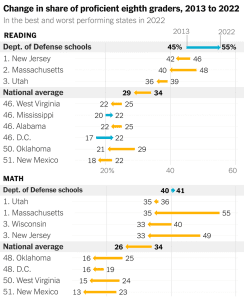
A Success Story by David Leonhardt
Improving America’s schools can sometimes seem like an impossible task. Politicians have been promising to do so for decades, yet the U.S. remains well behind many other countries in basic measures of learning. The Covid pandemic, with its extended school closures, aggravated the problems.But making progress really is possible, and a story by my colleague Sarah Mervosh describes perhaps the best case study. The network of schools run by the Defense Department has been performing well for years and continued to do so during the pandemic. These schools are typically on military bases, and they educate about 66,000 children of service members and Defense Department civilian employees.
Last year, this Top Performing Public School System outperformed all 50 states on reading and math scores for both eighth graders and fourth graders. Before the pandemic, the military schools did well but were not ranked No. 1. The schools also have smaller learning gaps between white and both Black and Hispanic students than other schools have.
“If the Department of Defense schools were a state, we would all be traveling there to figure out what’s going on,” Martin West, an education professor at Harvard, told Sarah.

Source: N.C.E.S. | By Ashley Wu
Perhaps the most important lesson is that the schools are excelling not by discovering some new secret about education. They are doing what decades of research has suggested is successful. “It is not surprising that they have good outcomes,” Douglas Harris, a Tulane professor who has studied the recent progress by a different school system — in New Orleans — told me. “It’s consistent with many decades of research about effective schools.”
High standards
Among the reasons the Defense Department schools do so well:
- Consistent with military culture, they set high standards and create a disciplined classroom culture. In 2015, the schools overhauled their curriculum using principles from the Common Core, a national program that many other districts have abandoned after criticism from both the political right and left. But the approach seems to benefit students. “Unlike the Common Core, which was carried out haphazardly across the country, the Defense Department’s plan was orchestrated with, well, military precision,” Sarah writes.
- Defense Department schools are racially and economically integrated. Asian, Black, Hispanic and white students attend the same schools. So do the children of Army privates earning $25,000 a year and the children of high-ranking officers earning six-figure salaries.
- The schools receive more funding than public schools in many states do. One teacher at an elementary school on Fort Moore in Georgia told The Times that she doubled her salary by switching from a traditional public school in Florida. The supply closets at Defense Department schools tend to be well-stocked, and teachers don’t have to pay for paper, pencils and books out of their own salaries, as is common elsewhere.
- During the pandemic, the military’s schools reopened relatively quickly — and it’s clear that extended closures were terrible for children. By December 2020, 85 percent of students at Defense Department schools were learning in person, officials told Sarah. Only a handful of states exceeded that share, according to the Covid-19 School Data Hub.
The share was below 10 percent in California, Kentucky, Maryland, Massachusetts, New Jersey, New York, North Carolina, Oregon, Pennsylvania, Virginia and several other states.
The Defense Department schools are hardly perfect. They also have some inherent advantages that other schools do not. More of their families have two married parents than is the case nationwide. By definition, at least one parent in each military family is employed. And the military provides health care and housing.
“Having as many of those basic needs met does help set the scene for learning to occur,” Jessica Thorne, an elementary school principal at Fort Moore, said.
Given this contrast, many other schools are unlikely ever to fare as well. Still, it would be a mistake to think that the military schools are thriving only because of the underlying differences in their students. After all, those differences have long existed — but the gaps between the Defense Department schools and all others have recently grown, especially among vulnerable students.
Consider these two striking comparisons from Sarah’s story: At Defense Department schools, Black and Hispanic eighth graders have higher reading scores than white students do nationwide on average. And eighth graders whose parents graduated only from high school performed as well in reading as students nationwide whose parents were college graduates.
For more, I recommend Sarah’s story and Kendrick Brinson’s accompanying photos, which take you inside Fort Moore’s schools.



